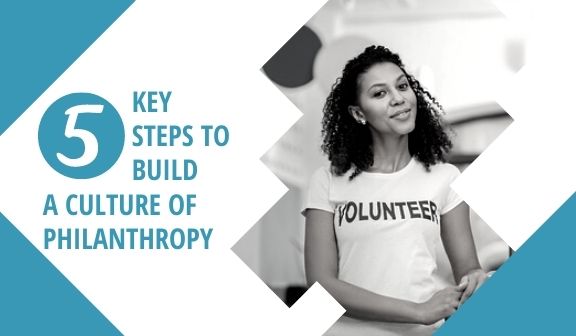Building a culture of philanthropy: it probably sounds like a dream—but kind of hard to achieve.
We had the opportunity recently to discuss this topic on a webinar with Danielle Shockey, CEO of Girl Scouts of Central Indiana, where she shared insights from her work growing a culture of philanthropy among the staff and volunteers at her organization. I’m excited to share some of the main points from our discussion.
What is a culture of philanthropy? We define it as: “One in which everyone—board, all staff, and the CEO— has a part to play in raising resources for the organization.”
The key driver behind a culture of philanthropy is the relationship—not just money.
When you have this culture in place, you are able to more closely connect fundraising to mission and programming. This in turn allows you to see donors holistically and be more donor-centric, utilize the strengths of the entire team, integrate the board in fundraising, and ultimately raise more money!
Here are five key steps to building a culture of philanthropy:
- Develop a shared responsibility for fundraising. Staff and volunteers need to act as ambassadors and engage in relationship building along all points of contact in your mission.
- Align fundraising with the mission. Philanthropy is a means to achieve the organization’s goals, and everyone needs to be able to articulate the case for supporting your mission.
- View fundraising as engagement. Fundraising should be valued and viewed as an opportunity for others to participate in the mission of the organization. Philanthropy allows donors to make an impact in the lives of those you support.
- Develop strong donor relationships. Put in place a consistent donor stewardship program that recognizes and thanks donors for their gifts no matter the size. Show them you value their relationship with your organization.
- Have a commitment from leadership—including the CEO and board. Ensure members of your leadership demonstrate their commitment and are personally engaged in fundraising for your organization.
Indicators of a strong culture of philanthropy include these characteristics:
- All departments (staff and volunteers) are collaborative and complementary, not siloed.
- Development goals are part of annual performance evaluations for all staff and board members.
- Publications, websites, social media, and other forms of communications feature donor stories,
describe impact, and tell how to give. - Staff members, board members, and donors have several opportunities to engage together to build trust and relationships.
- Investments are made to strengthen development/fundraising infrastructure, including professional development, training, and technology.
- All revenue streams—from special events, direct mail, major donors, online giving, grants, or others—are seen as equally important and valued.
- Donors, board members, and staff members have opportunities to share stories about their philanthropy. These stories, in turn, become the focus of development outreach, rather
than the organization communicating what it thinks is the case for support. - Results are measured by impact, not by arbitrary goals or deadlines.
Danielle Shockey shared some fantastic insights about just how she’s led the way in developing this culture at Girl Scouts of Central Indiana. At Girl Scouts, they put in place a cycle of three key strategies that staff, board, and development committee members utilize to keep this front of mind. This cycle embeds many of the strategies and characteristics we’ve already covered.
- Measurement/goal setting – Each board member, driven by the development committee, has an expectation to drive key goals in fundraising. They are given a menu of eight options—from hosting a cocktail event to writing thank you notes—and must complete at least two per year. Staff members have customized performance measurement goals, appropriate to their area and role, by which they are measured.
- Teaching/educating – Educating staff, volunteers, and board members about how to give, what gifts will do, and why this is important—the role of philanthropy in driving mission impact. We also talk about the power of story a lot, in fact it is a standing moment at each board meeting, and we have a repository of stories of impact that we make intentional additions to each month.
- Celebrate/reinforce – Celebrating successes and sharing stories of success have been made part of their regular habit. Each week, a staff email shares stories of success about donor connections staff have helped make possible.
Each organization can start at a different place as they work to develop a culture of philanthropy, depending on what is needed. Danielle’s advice is to decide where to start based on your organization’s unique situation, and continuously review these steps and assess on an ongoing basis.
![]()
